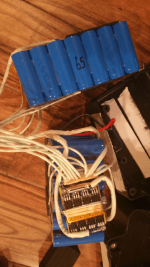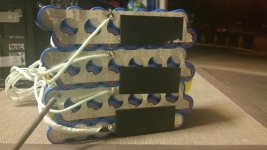Telemachus
10 W
I got a Jetson scooter/e-bike used 2 days ago. It's fun to ride, but I'm only getting about 8 miles before it turns off. The power just cuts off, especially if going up hill. I can open up the seat, turn the main power switch on and off, and then go another 100 yards until it cuts off again.
I opened up the battery tonight after the bike would go no longer to to check out the cells.
91 x 22650 cells, arranged in 13 groups of 7.
Each array measures 3.88-3.91V.
I am going to charge it overnight and see what they measure fully charged. I can also hook up the voltmeter to the battery terminals to see how low the voltage goes while running, but my guess is I am dropping below the minimum voltage since the display on the bike goes to one bar before it cuts off.
Is it more likely the controller shutting off power or the battery control system? Or are those just doing their job, and the battery is bad?
I opened up the battery tonight after the bike would go no longer to to check out the cells.
91 x 22650 cells, arranged in 13 groups of 7.
Each array measures 3.88-3.91V.
I am going to charge it overnight and see what they measure fully charged. I can also hook up the voltmeter to the battery terminals to see how low the voltage goes while running, but my guess is I am dropping below the minimum voltage since the display on the bike goes to one bar before it cuts off.
Is it more likely the controller shutting off power or the battery control system? Or are those just doing their job, and the battery is bad?



